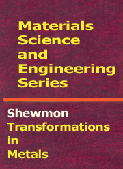Subtotal: 0.0
The distinguishing characteristic of a metallurgist (or ceramist) is an ability to work effectively with materials in which the properties depend on the microstructure evolved through prior treatment. These effects of prior history are commercially important and usually too complex to yield to any detailed mathematical analysis. This book provides an introduction to the concepts used in understanding the evolution of microstructure. It stems from a two-semester course taught to juniors in metallurgy who had had a prior course dealing with the atomic structure of solids, simple crystals, defects, and the existence of phase diagrams. It differs from the several books on physical metallurgy in that it covers fewer topics in more depth. The sequence has been chosen to go from the simpler to the more complex. Thus the material on dislocations and diffusion covered in the first chapters is used again in discussing recovery and solidification, the nucleation and solute redistribution concept covered in solidification are used again in treating phase transformation in solids, etc. The order of chapters and material has been chosen to allow the introduction of as few new concepts per chapter as possible, and the reinforcing of these concepts in the students mind by using them again and again in subsequent sections. This learning by using probably reaches an extreme in the case of phase diagrams, which are not given the customary full development in one chapter but are introduced in Chap.4, and then used extensively and further developed in Chaps.5, 6,7,and 8. In this way the material is presented not in the abstract but as an essential tool in discussing reactions occurring at and near equilibrium.
1. DISLOCATIONS
1-1 Strength of Perfect Crystals
1-2 Slip with Dislocations
1-3 Other Dislocation Characteristics
1-4 Dislocation Climb and Cross-slip
1-5 Dislocation Energy
1-6 Stress to Expand a Dislocations Loop
1-7 Dislocation Multiplication
1-8 Interaction between Dislocations
1-9 Interaction between Points Defects and Dislocations
1-10 Low-angle Grain Boundaries
1-11 Partial Dislocations
1-12 Stacking in Close-packed Lattices
1-13 Slip in fcc Crystals
2. DIFFUSION
2.1 Flux Equation
2.2 Steady-state Systems
2.3 Nonsteady-state Equations
2.4 Nonsteady-state Solutions
2.5 Atomic Mechanisms of Diffusion
2.6 Equilibrium Point Defect Concentration
2.7 Equations for D
2.8 Diffusion in Alloys
2.9 Atomic Mobility
2.10 Ternary Diffusion
2.11 Diffusion along Grain Boundaries
3. RECOVERY AND RECRYSTALLIZATION
3-1 Determination of Hv and Hmv
3-2 Annealing of Point Defects on Heating
3-3 Low-temperature Annealing
3-4 Dislocation Motion in Recovery
3-5 Transformations by Nucleation and Growth
3-6 Engineering Laws of Recrystallization
3-7 Nucleation in Recrystallization
3-8 Rate of Grain-boundary Motion
3-9 Recrystallization Textures
3-10 Hot Working
3-11 Grain Growth
3-12 Effect of Second Phase on Grain Growth
3-13 Equilibrium Microstructures
4. EQUILIBRIUM IN ALLOYS
4-1 Free-energy-Composition Diagrams
4-2 Eutectic or Eutectoid System
5 SOLIDIFICATION
5-1 Nucleation
5-2 Crystal Growth
5-3 Solute Redistribution on Freezing
5-4 Interface Stability and Dendrites
5-5 Eutectic Solidification
5-6 Ingot Structure
6 PHASE TRANSFORMATIONS NEAR EQUILIBRIUM
6-1 Nucleation in Solids
6-2 Ferrite Morphology and Growth Kinetics
6-3 The Pearlite Reaction: Cooperative Growth
6-4 Pearlite in Off-eutectoid Alloys
6-5 Bainite
6-6 TTT Diagrams for Steel
6-7 Transformations during Continuous Cooling
6-8 Precipitation in B Brass
6-9 Massive Transformations
6-10 Order-Disorder Transformations
6-11 Discontinuous Precipitation
6-12 Aluminum-Silver Alloys
7. PRECIPITATION HARDENING
7-1 Guinier-Preston Zones
7-2 Nucleation and Growth of Zones
7-3 Precipitate Coarsening
7-4 Quenched-in Vacancies
7-5 Transition Phases
7-6 Mechanism of Hardening
7-7 Commercial Precipitation-hardened Alloys
7-8 Dispersion-hardened Alloys
8 MARTENSITE
8-1 Characteristics of Martensitic Reactions
8-2 Thermodynamics
8-3 Shear Transformations
8-4 Mechanisms and Crystallography
8-5 Stabilization of Austenite
8-6 Diffusion-controlled Shear Transformations
8-7 Strength of Martensite
8-8 Tempering in Plain Carbon Steel
8-9 Tempering in Alloys Steel
9. GAS- METAL REACTIONS
9-1 Carburization of Steel
9-2 Oxidation
9-3 Parabolic Oxidation
9-4 Nucleation of Films
9-5 Oxidation of Alloys
9-6 Examples of Subsurface Reactions
9-7 External Protective Scale


Please Login To Write A Review
Login